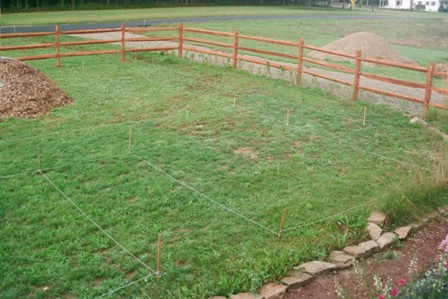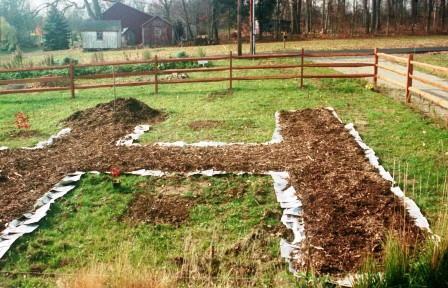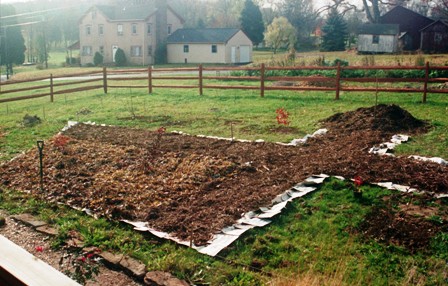In Part 1 of this post, I talked about some of the paths in my old garden. It’s been seven years since I left there, and six years since I started gardening here, and during those years, I’ve put a good bit of thought and work into the paths through this space. I’ve already written about the genesis of the timber-and-gravel path here, so I won’t bore you with that again, except to explain that it’s the main route from the front of the house to the back. As I thought about the space between that path and the outlying post-and-rail fence, it seemed natural to divide the center into a four-square pattern (or in this case, two squares and two sort-of-rectangles), with straight borders along the fencing.
 I worked out the proportions with stakes and string, allowing a full 6 feet of width for the main (middle) path, and 5 feet for other sections. This brings me to the most important thing I’ve learned about paths: It’s pretty much impossible to make them too wide. They looked appalling wide at first (and a big waste of potential gardening space, as well), but plants inevitably expand into that “free” space, and it doesn’t take long for them to take over even an extra-wide path if you let them.
I worked out the proportions with stakes and string, allowing a full 6 feet of width for the main (middle) path, and 5 feet for other sections. This brings me to the most important thing I’ve learned about paths: It’s pretty much impossible to make them too wide. They looked appalling wide at first (and a big waste of potential gardening space, as well), but plants inevitably expand into that “free” space, and it doesn’t take long for them to take over even an extra-wide path if you let them.
Breaking with tradition, I decided to build these paths before the beds. Putting a lot of money into permanent paving wasn’t an option at the time, so I decided to use wood chips, dumped for free by a tree-trimming crew working nearby. Mom and I covered the mostly bare soil with layers of newspaper or cardboard–or both, in some areas–and then covered that with a few inches of wood chips. Over the last few years, we’ve had to add more papers and more mulch (in the form of bulk-delivered double-shredded bark) a few times to smother the weeds and spruce things up.
I suppose that if I added up the time and money I’ve spent on the mulch, I’d regret not investing in more-permanent pathways at the very beginning. Another drawback is that the mulch layer is ideal for the germination of many seeds, so the paths require weeding several times during the growing season. But on the plus side, the mulch has a soft, springy feel underfoot, and the natural color makes a pleasing setting for the plants growing next to it. So on the whole, I’m happy with it.
Now that the areas inside the post-and-rail fence are pretty much established, I’m starting to develop spaces further out. Right now, most of them are single borders with the fence on one side and mown grass on the other, so paths there aren’t an issue yet. In what I call the Arc Borders, though, the planting area is wide enough to require some sort of access path, and I ended up leaving the path in grass for lack of time and budget for anything else. It’s functional, I guess, and it looks pretty, but oh, what a headache from a maintenance standpoint. Besides all the mowing, it requires tedious edging, too—not to make it look tidy so much as to keep the grass from creeping into the beds and mingling with the perennials. As soon as may be, this grass path will be history. But for now, I have to admit that I like looking at it, in pictures at least. Below are a few shots of the grass access path at different times this summer and fall.
And now, I promise I’m almost done rambling on about garden paths. Before I finish, though, I’d appreciate your input on something: Does it really bother you when plants sprawl into paths? I enjoy having them close enough to see, smell, and touch, so I tend to plant close to the edges of my paths, and I have no problem stepping over trailing shoots or lifting aside leaning stems. I’ve noticed, though, that many visitors don’t take kindly to getting up close and personal with bee-laden blossoms and scratchy grasses. Generally, I figure it’s their problem—if they’d wear proper footwear, long pants, and long sleeves instead of sandals, shorts, and t-shirts, they wouldn’t have to worry so much about getting stung, scratched, or stained. But maybe I’m being unreasonable? I suspect I am, and that I should make more of an effort to trim things back when I know visitors are coming. Or, perhaps I could just post an “Enter at Your Own Risk” sign at the gate?


